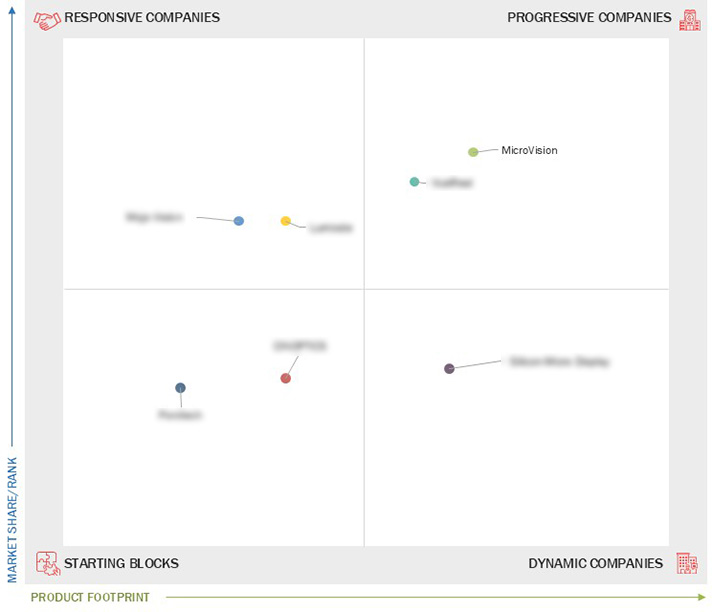Comparing 7 vendors in Near-Eye Display Startups across 0 criteria.
The current webpage discusses the growing market for near-eye display technologies, which are used in devices like AR and VR headsets. These displays are gaining traction across various sectors including consumer, industrial, medical, and education due to their immersive capabilities. Technologies such as OLED-on-silicon and MicroLED are driving innovation with their compact design and visual clarity. The market is expanding rapidly, supported by advancements in display resolution and strategic investments from major tech companies aiming to enhance user experiences across multiple applications.
Market Leadership Quadrant
1.1 Study Objectives
1.2 Market Definition
1.3 Study Scope
1.3.1 Markets Covered and Regional Scope
1.3.2 Inclusions and Exclusions
1.3.3 Years Considered
1.4 Currency Considered
1.5 Unit Considered
1.6 Limitations
1.7 Stakeholders
2.1 Introduction
2.2 Market Dynamics
2.2.1 Drivers
2.2.1.1 Rising demand for immersive technologies to enhance user experience
2.2.1.2 Rapid advancements in OLEDoS technology
2.2.1.3 Increasing adoption of near-eye displays in healthcare and defense sectors
2.2.1.4 Advancements in microdisplay technologies
2.2.1.5 Rising demand for advanced AR and VR technologies
2.2.2 Restraints
2.2.2.1 Limited availability of high-quality and engaging XR content
2.2.2.2 Health issues associated with excessive use of AR and VR devices
2.2.3 Opportunities
2.2.3.1 Ongoing innovations in near-eye display technologies
2.2.3.2 Surging investments in development of advanced display technologies
2.2.4 Challenges
2.2.4.1 Technical and usability challenges associated with HMDs
2.2.4.2 Complex manufacturing processes
2.3 Trends/Disruptions Impacting Customer Business
2.4 Value Chain Analysis
2.5 Ecosystem Analysis
2.6 Investment and Funding Scenario
2.7 Technology Analysis
2.7.1 Key Technologies
2.7.2 Complementary Technologies
2.7.3 Adjacent Technologies
2.8 Patent Analysis
2.9 Trade Analysis
2.10 Porter’s Five Forces Analysis
2.10.1 Threat of New Entrants
2.10.2 Threat of Substitutes
2.10.3 Bargaining Power of Suppliers
2.10.4 Bargaining Power of Buyers
2.10.5 Intensity of Competitive Rivalry
3.1 Introduction
3.2 Key Player Strategies/Right to Win
3.3 Revenue Analysis
3.4 Market Share Analysis
3.5 Company Valuation and Financial Metrics
3.6 Brand/Product Comparison
3.7 Company Evaluation Matrix: Startups/SMEs
3.7.1 Progressive Companies
3.7.2 Responsive Companies
3.7.3 Dynamic Companies
3.7.4 Starting Blocks
3.7.5 Competitive Benchmarking: Startups/SMEs
3.7.5.1 Detailed list of key startups/SMEs
3.7.5.2 Competitive benchmarking of key startups/SMEs
3.8 Competitive Scenario
3.8.1 Product Launches/Developments
3.8.2 Deals
3.8.3 Expansions
3.8.4 Other Developments
4.1 CINOPTICS
4.1.1 Business overview
4.1.2 Products/Solutions/Services offered
4.1.3 Recent developments
4.2 Lumiode
4.2.1 Business overview
4.2.2 Products/Solutions/Services offered
4.2.3 Recent developments
4.3 MICROVISION INC
4.3.1 Business overview
4.3.2 Products/Solutions/Services offered
4.3.3 Recent developments
4.4 Mojo Vision
4.4.1 Business overview
4.4.2 Products/Solutions/Services offered
4.4.3 Recent developments
4.5 Porotech
4.5.1 Business overview
4.5.2 Products/Solutions/Services offered
4.5.3 Recent developments
4.6 SILICON MICRO DISPLAY INC
4.6.1 Business overview
4.6.2 Products/Solutions/Services offered
4.6.3 Recent developments
4.7 VUEREAL INC.
4.7.1 Business overview
4.7.2 Products/Solutions/Services offered
4.7.3 Recent developments


 Photonics Spectra
Photonics Spectra
 Nov 2025
Nov 2025

